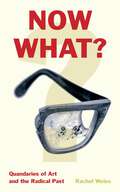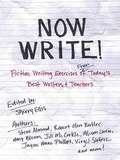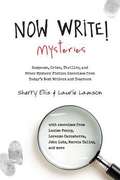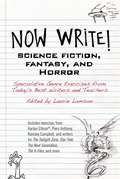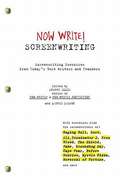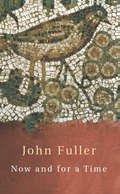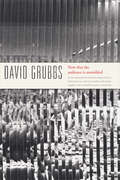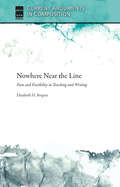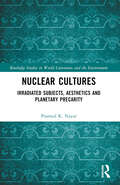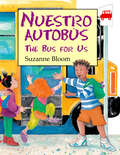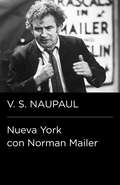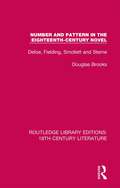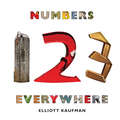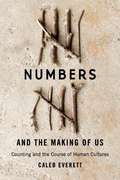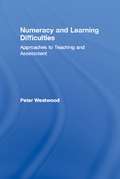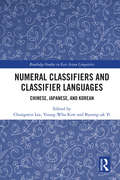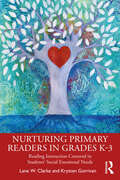- Table View
- List View
Now What?: Quandaries of Art and the Radical Past
by Rachel WeissNow What? is an innovative exploration of artworks and films that return to radical histories subject to erasure or otherwise lost or occluded over time. The moments returned to—the Cuban Revolution, Chile’s 1973 coup d’état, the ambiguous 1989 “revolution” in Romania, and the mayhem surrounding the Red Army Faction in 1970s West Germany—stand as historical watersheds, foundational and precipitate moments in the history of radical politics. Delving into these key historical moments by way of Tania Bruguera’s 2009 performance Tatlin’s Whisper in Havana, filmmaker Patricio Guzmán’s decades-long cycle of returns to Allende’s Chile, Harun Farocki and Andrei Ujica’s Videograms of a Revolution, Corneliu Porumboiu’s 12:08 East of Bucharest, the film Germany in Autumn, and Gerhard Richter’s October 18, 1977 suite of paintings, Rachel Weiss convincingly threads these works together through subtle and illuminating reflections on the complex dynamics involved in historical trauma and memory, addressing key questions about the meanings and uses of the past.
Now Write!
by Sherry EllisA collection of personal writing exercises and commentary from some of today's best novelists, short story writers, and writing teachers, including Jill McCorkle, Amy Bloom, Robert Olen Butler, Steve Almond, Jayne Anne Phillips, Virgil Suarez, Margot Livesay, and more. What's the secret behind the successful and prolific careers of critically acclaimed novelists and short story writers Amy Bloom, Steve Almond, Jayne Anne Phillips, Alison Lurie, and others? Divine assistance? Otherworldly talent? An unsettlingly close relationship with the Muse? While the rest of us are staring at blank sheets of paper, struggling to come up with a first sentence, these writers are busy polishing off story after story and novel after novel. Despite producing work that may seem effortless, all of them have a simple technique for fending off writer's block: the writing exercise. In Now Write!, Sherry Ellis collects the personal writing exercises of today's best writers and lays bare the secret to their success. - In "The Photograph," Jill McCorkle divulges one of her tactics for handling material that takes plots in a million different directions; - National Book Award-nominee Amy Bloom offers "Water Buddies," an exercise for writers practicing their craft in workshops; - Steve Almond, author of My Life in Heavy Metal and Candyfreak, provides a way to avoiding purple prose in "The Five-Second Shortcut to Writing in the Lyric Register"; - and eighty-three more of the country's top writers disclose their strategies for creating memorable prose. Complemented by brief commentary from the authors themselves, the exercises in Now Write! are practical and hands-on. By encouraging writers to shamelessly steal proven techniques that have yielded books which have won National Book Awards, Pulitzers, and Guggenheim grants, Now Write! inspires the aspiring writer to write now. .
Now Write! Mysteries
by Sherry EllisThe essential handbook for writers of whodunits, techno- thrillers, cozies, and everything in between-featuring never-before- published personal writing exercises from some of today's bestselling and award-winning mystery writers. Now Write! Mysteries, the fourth volume in the acclaimed Now Write! writing guide series, brings together numerous bestselling authors-including winners of and nominees for the Edgar, Hugo, and Shamus awards,-for the definitive guide to writing mysteries, thrillers, and suspense stories. Now Write! Mysteries teaches you everything you've ever wanted to know about crafting a page-turning mystery-from creating a believable detective hero (or terrifying villain), to using real-life cutting-edge investigative techniques to bring your story to life-with practical exercises taken directly from the pros: Discover the best techniques for seamlessly integrating action into your story with John Lutz, New York Times-bestselling author of Urge to Kill, Night Kills, and Serial. Learn how to fine-tune your sense of place and setting with Louise Penny, New York Times-bestselling author of the Armand Gamache mysteries. Take advice from Lorenzo Carcaterra, author of Sleepers and writer/producer for Law & Order, on how to compose a scene that lives up to your character's backstory. Let Marcia Talley, Agatha- and Anthony-winning author of the Hannah Ives mysteries, show you how to build a memorable, engaging detective. (Hint: It's not about making him flawless. ) No other mystery-writing guide offers the road tested wisdom of so many award-winners and bestselling authors in one place. .
Now Write! Nonfiction
by Sherry EllisAn essential handbook for nonfiction writers, featuring the trusted personal writing exercises of today's masters of creative non-fiction, including Gay Talese, Reza Aslan, John Matteson, Tilar Mazzeo, and many more! Beginners and seasoned writers alike will relish the opportunity to use the top-notch writing exercises collected in Now Write! Nonfictionculled from the personal stashes of bestselling and critically-acclaimed nonfiction authors like legendary essayist Gay Talese (Thy Neighbor's Wife), New York Times-bestselling authors Ishmael Beah (A Long Way Gone: Memoirs of a Boy Soldier) Reza Aslan (No God but God: The Origins, Evolution, and Future of Islam), and Tilar Mazzeo (The Widow Clicquot), 2008 Pulitzer Prize-winner John Matteson (Eden's Outcasts: The Story of Louisa May Alcott and Her Father), creative nonfiction icon Lee Gutkind (Creative Nonfictionmagazine), and many other top memoirists, journalists, and teachers of creative nonfiction, these exercises offer fresh ideas for every facet of creative nonfiction writing, from pushing through writers block to organizing a story, capturing character to fine-tuning dialogue, injecting new life into a finished piece to starting a new work from scratch. Now Write! Nonfictionwill take you out into the field with creative nonfiction's master practitioners: *Peek inside Gay Talese's mind, as he shares the "writer's road map" he used to organize information for his classic book Thy Neighbor's Wifeand his seminal essay "Frank Sinatra Has a Cold. " *Learn from Reza Aslan why what you rememberisn't as important as why you remember it the way you do *Explore the importance of cultural nuance in language with Ishmael Beah *Discover Lee Gutkind's simple trick, performed with a highlighter, that can help any writer identify whether their piece is truly showing action, or just telling An essential resource that will help writers of any level to hone their craft and get writing, Now WRite! Nonfictionoffers over 80 quick, simple excersises trusted by top nonfiction writers to get their pen moving!
Now Write! Science Fiction, Fantasy and Horror
by Laurie LamsonFeaturing speculative fiction-writing exercises from Harlan Ellison (R), Piers Anthony, Ramsey Campbell, Jack Ketchum, screenwriters of The Twilight Zone and Star Trek: The Next Generation, and many more. The fifth volume in the acclaimed Now Write! writing-guide series offers a full toolbox of advice and exercises for speculative fiction writers hoping to craft an engaging alternate reality, flesh out an enthralling fantasy quest, or dream up a bloodcurdling plot twist, including: -Harlan Ellison (R), on crafting the perfect story title -Jack Ketchum, on how economy of language helps create a truly frightening tale -Piers Antony, on making fantastical characters feel genuine and relatable This collection of storytelling secrets from top genre writers-including winners of Nebula, Hugo, Edgar, and Bram Stoker awards-is essential for any writer looking to take a leap beyond the ordinary. .
Now Write! Screenwriting
by Ellis Sherry Laurie LamsonAn essential handbook featuring never-before-published writing exercises from the acclaimed screenwriters of Raging Bull, Ali, Terminator 2, Fame, Groundhog Day, Cape Fear, "Lost", "True Blood", "The Shield", and many other hit films and television shows. Now Write! Screenwriting-the latest addition to the Now Write! writing guide series-brings together the acclaimed screenwriters of films like the Oscar-winning Raging Bull, Oscar- nominated Ali, era-defining blockbuster Terminator 2, musical classic Fame, hit series "Lost" "True Blood" and "The Shield," Groundhog Day, Cape Fear, Chicken Run, Reversal of Fortune, Before Sunrise, Mystic Pizza, Indecent Proposal, and many more, to teach the art of the story. *Learn about why it is sometimes best to write what you don't know from Christina Kim ('Lost') *Find out how Stephen Rivele (Ali, Nixon) reduces his screenplay ideas down to their most basic elements, and uses that as a writing guide *Learn why you should focus on your character, not your plot, when digging yourself out of a plot home from Danny Rubin (Groundhog Day) *Take tips from Karey Kirkpatrick (Chicken Run, The Spiderwick Chronicles) on how to give an inanimate object intense emotional significance *Let Kim Krizan (Before Sunrise, Before Sunset) teach you how to stop your internal critic dead in his tracks This lively and easy-to-read guide will motivate both aspiring and experienced screenwriters. No other screenwriting book offers advice and exercises from this many writers of successful, iconic films. .
Now You're Talking: Human Conversation from the Neanderthals to Artificial Intelligence
by Trevor CoxA history of how humans developed our capacity for conversation—and what might happen now that computers are catching up.Trevor Cox has been described by The Observer as ""a David Attenborough of the acoustic realm."" In Now You're Talking, he takes us on a journey through the wonders of human speech, starting with the evolution of language and our biological capability to speak (and listen), and bringing us up to date with the latest computer technology.Language is what makes us human, and how we speak is integral to our personal identity. But with the invention of sound recording and the arrival of the electrified voice, human communication changed forever; now advances in computer science and artificial intelligence are promising an even greater transformation. And with it come the possibilities to reproduce, manipulate, and replicate the human voice—sometimes with disturbing consequences.Now You're Talking is the fascinating story of our ability to converse. It takes us back to the core of our humanity, asking important questions about what makes us human and how this uniqueness might be threatened. On this illuminating tour we meet vocal coaches and record producers, neuroscientists and computer programmers, whose experience and research provide us with a deeper understanding of something that most of us take for granted—our ability to talk and listen.
Now and for a Time
by John FullerThroughout his long and prolific career, John Fuller has been admired for the way in which he melds levity with serious reflection. In this beautiful new collection of twenty-one poems he proves himself, once again, a true master of this art. They take us from birth to death: from a baby's first delightful babblings, to the dignified, measured words of a man surveying his life and marriage, and looking forward into the unknown. There are moments of great joie de vivre, of pleasure in the earthy things of life; and yet, beyond, there is always a sense of a vaster, more elusive universe. The snorting of the horses in a field in 'Dreams', the egret on the rock in 'Sentinel': these are nature's mysteries. To make sense of these, we have language and music. Celebratory, playful, reconciled to the questions that will not be answered, these poems exude a miraculous kind of peace and understanding: 'A point of closure that allows the next/Inevitable sentence to begin'.
Now that the audience is assembled
by David GrubbsFollowing his investigation into experimental music and sound recording in Records Ruin the Landscape, David Grubbs turns his attention to the live performance of improvised music with an altogether different form of writing. Now that the audience is assembled is a book-length prose poem that describes a fictional musical performance during which an unnamed musician improvises the construction of a series of invented instruments before an audience that is alternately contemplative, participatory, disputatious, and asleep. Over the course of this phantasmagorical all-night concert, repeated interruptions take the form of in-depth discussions and musical demonstrations. Both a work of literature and a study of music, Now that the audience is assembled explores the categories of improvised music, solo performance, text scores, instrument building, aesthetic deskilling and reskilling, and the odd fate of the composer in experimental music.
Nowhere Near the Line: Pain and Possibility in Teaching and Writing
by Elizabeth Boquet“When I was starting College Presidents for Gun Safety, one of the concerns I heard was the idea that there were just too many issues on which to articulate an opinion. Where would it stop? Where would we draw the line? . . . In light of this latest tragedy, on a college campus that could have been any of ours, I would say: ‘We are nowhere near the line yet.’” (Lawrence Schall, quoted in “Tragedy at Umpqua,” by Paul Fain, Inside Higher Ed, October 2, 2015) In this short work, Elizabeth Boquet explores the line Lawrence Schall describes above, tracing the overlaps and intersections of a lifelong education around guns and violence, as a student, a teacher, a feminist, a daughter, a wife, a citizen and across the dislocations and relocations that are part of a life lived in and around school. Weaving narratives of family, the university classroom and administration, her husband’s work as a police officer, and her work with students and the Poetry for Peace effort that her writing center sponsors in the local schools, she recounts her efforts to respond to moments of violence with a pedagogy of peace. “Can we not acknowledge that our experiences with pain anywhere should render us more, not less, capable of responding to it everywhere?” she asks. “Compassion, it seems to me, is an infinitely renewable resource.”
Nuclear Cultures: Irradiated Subjects, Aesthetics and Planetary Precarity (Routledge Studies in World Literatures and the Environment)
by Pramod K. NayarNuclear Cultures: Irradiated Subjects, Aesthetics and Planetary Precarity aims to develop the field of nuclear humanities and the powerful ability of literary and cultural representations of science and catastrophe to shape the meaning of historic events. Examining multiple discourses and textual materials, including fiction, poetry, biographies, comics, paintings, documentary and photography, this volume will illuminate the cultural, ecological and social impact of nuclearization narratives. Furthermore, this text explores themes such as the cultures of atomic scientists, the making of the bomb, nuclear bombings and disasters, nuclear aesthetics and art, and the global mobilization against nuclearization. Nuclear Cultures breaks new ground in the debates on "the nuclear" to foster the development of nuclear humanities, its vocabulary and methodology.
Nuestro Autobús
by Suzanne BloomTess is excited. Today is her first day of school and her very first ride on a school bus. Waiting at the bus stop with her older friend Gus, Tess eagerly asks, "Is this the bus for us, Gus?" as each vehicle passes by. From fire engine to front loader, Suzanne Bloom introduces young readers to a variety of vehicles through a simple text and spirited illustrations.
Nueva York con Norman Mailer (Colección Endebate #Volumen)
by V.S. NaipaulV.S. Naipaul sigue como periodista la legendaria campaña de Norman Mailer a la alcaldía de Nueva York en 1969. La política estadounidense vivió numerosos sobresaltos en los años 60. Uno de ellos fue la mediática campaña del polémico escritor Norman Mailer a la alcaldía de Nueva York. A su lado, durante la mayor parte de la campaña, estuvo Naipaul, que fue recogiendo en sus crónicas cómo la trituradora de la política iba deshaciendo la ilusión y la resistencia del incauto Mailer y su entusiasta equipo.
Nuevas maneras de matar a tu madre
by Colm Tóibín¿Quién dijo que todas las familias felices, o que lo parecen, son iguales? Toibin tiene su propia opinión al respecto. Colm Toibín aborda en este libro inclasificable, a caballo entre el ensayo y la narración, la siempre problemática y jugosa relación de los escritores y sus familias. Con una asombrosa perspicacia psicológica, con fino sentido del humor, lucidez crítica y contagioso fervor, reconstruye, entre otras, la historia de W. B. Yeats con su padre, la terrible paternidad de Thomas Mann o el tortuoso matrimonio de John Cheever. En piezas que tratan de la importancia de las parientes pobres o la muerte de los padres en la novela del XIX, hasta la perversa vinculación entre una generación y otra, Toibín nos habla de algo muy próximo, íntimo, pero acaba celebrando el poder y el misterio de la gran literatura. Divertido, hondo y sagaz, Nuevas maneras de matar a tu madre muestra una vez más el talento de uno de los grandes escritores de la actual literatura anglosajona. Reseña:«Toibín es un guía perfecto para llevarnos a la tierra de los deseos inconfesables.»London Evening Standard
Number and Pattern in the Eighteenth-Century Novel: Defoe, Fielding, Smollett and Sterne (Routledge Library Editions: 18th Century Literature)
by Douglas BrooksNumerological patterning in literature, where structural details of a literary work are symbolically related to its meaning on the verbal level, was particularly common from the Middle Ages up to the seventeenth century. Originally published in 1973, the author breaks new ground in revealing that familiarity with this technique lived on into the eighteenth century, supplying the more artistically aware of the early British novelists with meaningful formal guidelines. An account is given of the origins and continuity of the numerological tradition in Western European – and particularly English – thought as it affected literary structure. The careful structural patterning in the novels of Defoe and in Fielding’s Joseph Andrews and Tom Jones is examined in detail. Smollett, too, is shown to have been interested in exploring the possibilities of number and pattern, and the clear-cut numerological framework of Sterne’s Tristram Shandy is revealed. This original and controversial study combines structural analysis with fresh interpretative insights, and draws parallels with painting, music and architecture. It also has an important bearing on the history of ideas in the first half of the eighteenth century.
Number the Stars (SparkNotes Literature Guide Series)
by SparkNotesNumber the Stars (SparkNotes Literature Guide) by Lois Lowry Making the reading experience fun! Created by Harvard students for students everywhere, SparkNotes is a new breed of study guide: smarter, better, faster. Geared to what today's students need to know, SparkNotes provides: *Chapter-by-chapter analysis *Explanations of key themes, motifs, and symbols *A review quiz and essay topicsLively and accessible, these guides are perfect for late-night studying and writing papers
Numbers Everywhere
by Elliott KaufmanAs in Alphabet Everywhere, where there was a world of letters just waiting to be discovered, Numbers Everywhere reveals how digits and mathematical symbols can be found in the world around us -- if we know how to look for them.
Numbers and the Making of Us: Counting and the Course of Human Cultures
by Caleb EverettNumber concepts are a human invention developed and refined over millennia. They allow us to grasp quantities precisely: recent research shows that most specific quantities are not perceived in the absence of a number system. Numbers are not innate or universal; yet without them, the world as we know it would not exist.
Numeracy and Learning Difficulties: Approaches to Teaching and Assessment (Learning Difficulties Ser.)
by Peter WestwoodBy understanding why children struggle with maths, teachers are better equipped to provide effective support and nurture confidence in low-achievers. Numeracy and Learning Difficulties includes how to tackle common learning difficulties by following different teaching practices and principles, identifying gaps in students' knowledge and developing curricula that bridges these gaps, improves numerical literacy using problem-solving strategies and skills, and a handy checklist of benchmarks in achievement.
Numeral Classifiers and Classifier Languages: Chinese, Japanese, and Korean (Routledge Studies in East Asian Linguistics)
by Chungmin Lee; Young-Wha Kim; Byeong-uk YiFocusing mainly on classifiers, Numeral Classifiers and Classifier Languages offers a deep investigation of three major classifier languages: Chinese, Japanese, and Korean. This book provides detailed discussions well supported by empirical evidence and corpus analyses. Theoretical hypotheses regarding differences and commonalities between numeral classifier languages and other mainly article languages are tested to seek universals or typological characteristics. The essays collected here from leading scholars in different fields promise to be greatly significant in the field of linguistics for several reasons. First, it targets three representative classifier languages in Asia. It also provides critical clues and suggests solutions to syntactic, semantic, psychological, and philosophical issues about classifier constructions. Finally, it addresses ensuing debates that may arise in the field of linguistics in general and neighboring inter-disciplinary areas. This book should be of great interest to advanced students and scholars of East Asian languages.
Nunca lo hubiera dicho: Los secretos bien guardados (o no tanto) de la lengua española
by Real Academia Española Asociación de Academias de la Lengua EspañolaEl desembarco de la Real Academia Española en la divulgación. Nunca lo hubiera dicho es el primer volumen de la colección «Hablantes», preparada por la Real Academia Española y la Asociación de Academias de la Lengua Española. En él se abordan de manera clara y amena asuntos poco conocidos y anécdotas relacionados con la historia del español, el léxico, la ortografía o la gramática: castellano o español, el mito del español más puro, el «color especial» de América, la discreción de la letra hache, los acentos que engañan, la palabra que no se puede escribir... Los abundantes ejemplos tomados de la realidad (prensa, publicidad, etc.) resultan divertidos o sorprendentes para todos los lectores. Porque disfrutar de nuestra lengua descubriendo sus secretos puede ser el mejor plan. Con prólogo de Soledad Puértolas, de la Real Academia Española.
Nur Baba: A Sufi Novel of Late Ottoman Istanbul (Routledge Sufi Series)
by Yakup Kadri KaraosmanoğluThis first-ever English translation of Nur Baba – a classic of modern Turkish literature written by Yakup Kadri Karaosmanoğlu – offers a unique window into Sufi lodges, social dilemmas, and intellectual life in early twentieth-century Istanbul. Inspired by Karaosmanoğlu’s personal experiences with Islamic mystical orders, it is a story of illicit romance and spiritual inquiry, depicting a colourful lodge of Sufi dervishes led by a charismatic, yet morally suspect, spiritual master named Nur Baba. The plot follows his attempts to seduce an attractive married woman from an elite family and recounts her dramatic experiences in the life of a Sufi community. The setting shuttles between the grand mansions of Istanbul’s elite families and a Sufi lodge where rich and poor intermingle. Exploring questions of gender, morality, and religious bias throughout, it captures the zeitgeist of early twentieth-century modernist thinkers who criticised Sufism for impeding social progress and debated the public roles of women in a rapidly modernising society. Alongside the editor’s meticulous translation, the volume includes a scholarly introduction, maps, and images, as well as explanatory footnotes that will aid both students and scholars alike. The novel will be of particular interest to those studying world literature, Sufi studies, and Ottoman-Turkish history.
Nurse Memoirs from the Great War in Britain, France, and Germany (Palgrave Studies in Literature, Science and Medicine)
by Jerry PalmerNurse Memoirs from the Great War in Britain, France, and Germany examines an understudied corpus of memoirs in English, French, and German stemming from the unprecedented involvement of women in the war effort. Jerry Palmer considers the memoirs in relationship to public opinion, collective memory and other women’s writing about the war. Through close-readings of the memoirs and their contexts, the book identifies themes present in the texts and considers the nurse memoir as rhetoric—examining to what extent the texts are promoting or countering arguments in the public sphere about their involvement or more widely about women’s position in society. Palmer explores the multiple contexts related to the nurse memoirs, including public response to volunteer wartime nursing, the organisation of the military health services of the three nations and their conduct in the war, and changes in the post-war organization of public health services and the professionalization of nursing.
Nurturing Primary Readers in Grades K-3: Reading Instruction Centered in Students' Social Emotional Needs
by Lane W. Clarke Krysten GorrivanWeaving together reading pedagogy and social emotional learning (SEL) frameworks, this text presents an integrated, research-based approach to reading instruction grounded in instructional and collaborative strategies that address students’ social emotional needs. The text features real stories from the classroom to invite readers to learn alongside the students, teachers, families, and professionals as they experience journeys of growth. The authentic case studies cover best practices in reading instruction in a way that centers students, promotes the whole child, and supports reading growth. Following a cyclical framework – discovering, nurturing, growing – each chapter addresses typical student reading needs and explains the role of collaborative relationships in effective instruction. Through the medium of storytelling, readers gain profound insights into key topics, including teaching multilingual students, phonological awareness, reading fluency, and more. Accessible and comprehensive, this book steers away from a prescriptive recipe for instruction but rather leaves readers with an effective framework for incorporating data-based decision-making, collaboration, and research-supported literacy practices to foster each student's social and emotional skills in the classroom. With a targeted focus on K-3 classrooms, this text is a key resource for pre-service and in-service educators in literacy education and elementary education, enriching the perspectives of all educators.
Nutzungsmuster digitaler Anwendungen im Fachunterricht: Empirische Analysen unter besonderer Berücksichtigung von Fremdsprachenlehrkräften in Deutschland
by Jan NiemannIn diesem Buch werden empirische Befunde zu Mediennutzungsmustern digitaler Anwendungen im Fachunterricht in Verbindung mit Bedingungsfaktoren der Mediennutzung präsentiert, wobei insbesondere das Mediennutzungsverhalten von Fremdsprachenlehrkräften in Deutschland fokussiert wird. Die Ergebnisse der auf quantitativen Sekundäranalysen der International Computer and Information Literacy Study (ICILS) beruhenden empirischen Studie deuten auf fachgruppenspezifische Unterschiede in den Mediennutzungsmustern und den jeweiligen Bedingungsfaktoren hin. Dabei scheinen für Fremdsprachenlehrkräfte u.a. digitale Verknüpfungen mit Schulbüchern und digitale Schulbücher besonders relevante digitale Anwendungen für die Nutzung im Fachunterricht zu sein. Als zentraler Bedingungsfaktor für die Zugehörigkeit zu einem bestimmten Mediennutzungsmuster werden für Fremdsprachenlehrkräfte in Deutschland darüber hinaus digitalisierungsbezogene Einstellungen identifiziert. Die Ergebnisse werden im Hinblick auf ihre forschungs- und praxisbezogene Relevanz im Kontext der empirischen Bildungsforschung diskutiert.
